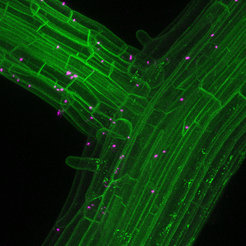Nitrogen-fixing bacteria and their plant hosts: old friends that go way back
The relationship between so-called rhizobia, nitrogen-fixing bacteria that are mostly from the order Rhizobiales, and leguminous plants is one of the best-characterized beneficial plant-microbe interactions in all of nature. However, non-legumes harbor Rhizobiales species that do not fix nitrogen, and when and how this trait evolved has remained unclear. Now, research led by scientists at the Max Planck Institute for Plant Breeding Research (MPIPZ) in Cologne, Germany, has traced the evolutionary history of nitrogen fixation in Rhizobiales and revealed important additional functions of these microbes. The team’s findings are published in the journal Cell Host & Microbe.

Rhizobiales bacteria (magenta) in association with plant roots (green)
The plant microbiota, the collection of microorganisms associated with healthy plants, carries out many important functions for its hosts, not least by improving nutrient availability. Plants require large amounts of nitrogen for optimal growth and certain soilborne bacteria, collectively known as rhizobia, have evolved the ability to fix atmospheric nitrogen within nodules in the roots of leguminous plants and then make it available to the plant host. This ability of rhizobia to obtain nitrogen from the atmosphere relies on dedicated signaling molecules that can be thought of as constituting a toolkit for nitrogen fixation.
In order to track when the nitrogen fixation toolkit was acquired during Rhizobiales evolution, a research team led by Paul Schulze-Lefert at the MPIPZ collaborated with the US-based biotechnology company AgBiome and undertook a massive isolation and genome sequencing effort in which they characterized almost 1,000 Rhizobiales species – both those associated with the roots of legumes as well as those originating from non-leguminous plants and other associated environments, such as soil or insects.
Analysis of this wealth of sequencing data confirms Rhizobiales bacteria to be major components of the plant microbiota across many diverse plant species. Surprisingly, however, the vast majority of these plant-associated Rhizobiales from non-legumes lack the nitrogen fixation toolkit, and the ability to fix nitrogen was not acquired once but rather evolved multiple independent times.
“The fact that these non-nitrogen-fixing Rhizobiales are so prevalent in non-legume roots suggested to us that they might be engaged in some other important interactions with their plant hosts,” says Ryohei Thomas Nakano, one of three co-first authors of the study.
To tease out what these interactions might be, the authors took advantage of their vast collection of isolated microorganisms and reintroduced single or multiple bacteria back into microbe-free Arabidopsis thaliana plants, commonly used to study microbe-plant interactions, and studied the impact on plant physiology. The majority of the tested rhizobia stimulated root growth in inoculated plants. Further, some of the tested Rhizobiales strains also elicited widespread changes in gene expression in plants resulting in a dampening of immune responses, which may have important implications for how microbiota members colonize plant roots.
Not only have the non-nitrogen-fixing Rhizobiales adapted to their plant hosts, they also engage in complex interactions with each other. Some combinations of bacteria were capable of triggering enhanced root growth even when neither of them could individually.
“It had been thought that the ability to fix nitrogen allowed these bacteria to adapt to their plant hosts. However, our results suggest that Rhizobiales bacteria first adapted to their host plants and only then acquired the ability to fix nitrogen,” says Ruben Garrido-Oter, co-first author of the study.
Team leader Paul Schulze-Lefert emphasizes the power of the experimental approach: “Our study is a great example of how much information and insight we can get from first systematically isolating and characterizing plant-associated microbes and their genomes and then re-introducing the bacteria to germ-free plants to study their individual and combined impact on plant physiology.”
The authors’ findings reveal the surprisingly long history of a key plant-microbe relationship. They now want to identify the molecules produced by the non-nitrogen-fixing Rhizobiales that enable them to dampen plant immune responses and to promote root growth in non-legume plant species.
